
Journal of Science and Transport Technology Vol. 2 No. 1, 21-30
Journal of Science and Transport Technology
Journal homepage: https://jstt.vn/index.php/en
JSTT 2022, 2 (1), 21-30
Published online 14/03/2022
Article info
Type of article:
Original research paper
DOI:
https://doi.org/10.58845/jstt.utt.2
022.en.2.1.21-30
*Corresponding author:
E-mail address:
quy.nguyenvan@hust.edu.vn
Received: 11/12/2021
Revised: 27/02/2022
Accepted: 01/03/2022
Application of an artificial neural network and
QCM sensor coated with γ-Fe2O3
nanoparticles for estimation of SO2 gas
sensing characteristics
Nguyen Thanh Vinh1,2, Tran Quoc Tuan1, Nguyen Van Cuong1, Cao Xuan
Truong2, Nguyen Van Quy2*
1University of Transport Technology, No. 54 Trieu Khuc, Thanh Xuan District,
Ha Noi 100000, Viet Nam
2International Training Institute for Materials Science, Ha Noi University of
Science and Technology, No. 1 Dai Co Viet, Hai Ba Trung District, Ha Noi
100000, Viet Nam
Abstract: γ-Fe2O3 nanoparticles (NPs) were synthesized by co-precipitation
method and a following annealing treatment at 200 C in ambient air for 6
hours. A mass-type sensor was prepared by coating γ-Fe2O3 NPs on the active
electrode of quartz crystal microbalance (QCM). The obtained results of the γ-
Fe2O3 NPs based QCM sensor indicate the high response and good
repeatability toward SO2 gas in the range of 2.5 – 20 ppm at room temperature.
Moreover, the frequency shift (F) and change in mass of SO2 adsorption per
unit area (m) of the γ-Fe2O3 NPs coated QCM sensor have a relationship with
the mass density of γ-Fe2O3 NPs and SO2 concentrations. The artificial neural
network (ANN) model using Levenberg-Marquardt optimization was used to
handle the F and m of the γ-Fe2O3 NPs coated QCM sensor. The results of
the model validation proved to be a reliable way between the experiment and
prediction values.
Keywords: QCM, SO2, γ-Fe2O3, gas sensor, ANN.
1. Introduction
Nowadays, the development of modern
society has created many sources of pollution
emission. One of the major global concerns is air
pollution which puts pressure on governments or
countries as well as, negative effects on health and
quality of human daily life [1], [2], [3]. Among them,
sulfur dioxide (SO2) is always in the top toxic gases
causing respiratory diseases, bronchoconstriction
and dyspnea [2], [4], [5]. Therefore, air quality
guidelines are developed and continuously
updated by the World Health Organization (WHO).
The current standard of air quality is 20 μg/m3 (8
ppb) and 500 μg/m3 (190 ppb) when people expose
to SO2 for 24 hours and 10 minutes, respectively
[6]. The immediate danger to life and health (IDLH)
values and the short-term exposure limit (TLV-
STEL) of SO2 according to ACGIH are 100 and 5
ppm, respectively [7]. However, according to P.D.
Hien’s report on the air pollution level of the urban
districts of Ha Noi, Viet Nam in 2020, the SO2
concentrations reached the highest point of 35
μg/m3 in Hoan Kiem, while Thanh Xuan was 22.5
(μg/m3) [8]. These pollution levels were higher than
those recommended by WHO. Accordingly, SO2
sensors must be seriously considered and

JSTT 2022, 2 (1), 21-30
Nguyen et al
22
developed. These works could contribute to
environmental pollution monitoring and ensuring
social guarantee.
Currently, there are many types of SO2
sensors that have been successfully developed
with different operation principles [9], [10], [11],
[12]. Among them, the mass-type sensor using
quartz crystal microbalance (QCM) is highly
appreciated for its low power consumption, good
response (nanogram level) and stable operation at
room temperature [13], [14]. QCM sensors coated
with iron oxide show excellent detection
performance to SO2 gas [15]–[17], and γ-Fe2O3 is
an outstanding sensing material [18], [19]. So far,
numerous researches have been published for the
purpose of protease, alcohol and gas classification
using QCM sensors, which were supported by
machine learning [20]–[23], [24]. The positive
results show the considerable application potential
of this field. However, machine learning is less
common in SO2 detection studies of QCM sensors
in general and QCM coated with γ-Fe2O3 in
particular. Therefore, in this work, the SO2 sensor
was made from γ-Fe2O3 nanoparticles (NPs)
coated on the gold electrode of QCM. The basic
characteristics of sensor were investigated, and
these experimental data were used for a machine
learning. The built algorithm was used to predict
the output signals of QCM sensor (frequency
shift/F, and the mass change of adsorption SO2
per unit area of sensing material/m), these
predictions agree with the experimental results
after the training process.
2. Experiment
2.1. γ-Fe2O3 NPs synthesis
The chemicals used in this experiment were
ferric chloride hexahydrate (FeCl3.6H2O, > 98%),
ferrous chloride tetrahydrate (FeCl2.4H2O, > 98%)
and sodium hydroxide (NaOH, >98%). These
chemicals were purchased from Xilong Scientific
Co., Ltd. (Guang-dong, China).
In this work, γ-Fe2O3 NPs were synthesized
through co-precipitation, followed by annealing
treatment. The detail of synthesis process was
described in our previous publication [19]. In brief,
the precursors of FeCl3.6H2O (0,05 mol) and
FeCl2.4H2O (0,025 mol) were dissolved in
deionized water (DI). 2M NaOH was then added to
this mixed solution at 80 C. The precipitate was
dried and calcined at 200 C in ambient air for 6
hours to obtain γ-Fe2O3 NPs. The as-prepared γ-
Fe2O3 NPs was dissolved and deposited on the
electrode of QCM by using spray-coating method
[17]. γ-Fe2O3 NPs were crushed and dispersed in
DI with a concentration of 1 mg ml-1. In order to
fabricate a QCM sensor, 3 ml of dispersed solution
was used for each experiment at the flow rate of
0.2 ml min-1. SO2 sensing characteristics of QCM
sensor were performed with the change in γ-Fe2O3
NPs layer. The number of sensing material layers,
γ-Fe2O3 NPs mass density deposited on the
electrode (m_γ-Fe2O3) and the resonance
frequency of QCM (F-resonance) corresponding to
each layer are shown in Table 1.
Table 1. The parameters of QCM sensor was
fabricated
No.
Layer
F-resonance
(Hz)
m_γ-Fe2O3
(μg.cm-2)
uncoated
5001725.8
0
1
1st
4995656.1
107.24
2
2nd
4989780.1
211.05
3
3rd
4983067.6
329.65
4
4th
4978063.8
418.06
5
5th
4973373.8
500.92
6
6th
4967813.1
599.16
7
7th
4962879.0
686.34
The gas sensor properties were investigated
with SO2 gas through a home-made measurement
system and QCM200 digital controller linked to PC
by using SRSQCM200 software program [25], [26].
XRD pattern of γ-Fe2O3 was recorded in the range
of 2θ: 20 – 70o using Cu Kα radiation with λ of
0.1542 nm. The morphology of iron oxide was
observed by S-4800 Scanning Electron
Microscopy device (Hitachi).
2.2. Machine learning for estimation of QCM
frequency shift and the mass change of
adsorption SO2 per unit area
2.2.1. Artificial Neural Network

JSTT 2022, 2 (1), 21-30
Nguyen et al
23
Artificial Neural Network (ANN) is an useful
algorithm for solving prediction and classification
problems [27], [28]. In this work, the experimental
data were used for the development of an ANN
model. The Levenberg-Marquardt algorithm was
considered the most suitable for ANN with a
training dataset [28], [29]. Therefore, ANN based
on the Levenberg-Marquardt algorithm was used in
this study to optimize the searching process for
neurons weights and biases.
2.2.2. Cross-fold validation
Cross-validation (CV) is a popular technique
to evaluate a model more fully and accurately for
the moderate-sized training in the field of machine
learning. In k-Fold cross-validation (k-Fold CV), the
training dataset is randomly split into subsets of
approximately equal size (k is an integer). The
machine is trained k times in which one random
subset is selected as the validation data, the other
subsets (k-1) are selected as the training data for
each time. The cross-validation estimate of
accuracy results from the average evaluation of all
runs [30]. In this work, k = 10 was chosen to split
the training dataset due to minor errors and low
variances through experimentation [31]. On the
other hand, the test dataset checks the model’s
response in the final step when dealing with
unseen data.
2.2.3. Model evaluation
In this paper, the coefficient of determination
(R2) and the root of the mean square error (RMSE)
are used to evaluate the accuracy of the machine
learning model in predicting m and F. Precisely,
R2 shows the square correlation between the
predicted value and the actual value, RMSE index
calculates the average of the square of the
difference between the predicted value and the
actual value. These values are determined by
equations (1) [32] and (2) [33]:
( )
=
=−
m2
ii
i1
1
RMSE e m
n
( ) ( )
( ) ( )
=
==
−−
=
−−
m
ii
2i1
mm
22
ii
i 1 i 1
e e m m
R
e e m m
Where ei is the estimated value and mi is the
measured value;
e
and
m
are the average of
estimated value and measured value, respectively.
3. Results and discussion
3.1. The crystalline structure and
morphological of as-prepared sample
Fig. 1. (a) XRD, (b) SEM of γ-Fe2O3 NPs and image of QCM sensor coated with γ-Fe2O3 NPs
Fig. 1 shows the morphological and structural
characteristics of γ-Fe2O3 material via XRD and
SEM results. The XRD pattern of the as-prepared
sample is indicated in Fig. 1a. The strong diffraction
peaks at about 30.3, 35.4, 43.2, 53.4, 57.1,
and 62.6 are well-matched with the (220), (311),

JSTT 2022, 2 (1), 21-30
Nguyen et al
24
(400), (422), (511) and (440) lattice planes,
respectively. In comparison with the standard cards
(JCPDS No. 19 – 0629 and No. 39.1346), it is
clearly seen that the as-prepared iron oxide
material is either Fe3O4 or γ-Fe2O3. However,
Fe3O4 material was transferred to γ-Fe2O3 at 200
C due to magnetite oxidation and their similar to
crystal structures [18], [34], [35], [36]. Thus, the
crystallite of the synthesized iron oxide in this work
indicates a crystal structure of γ-Fe2O3. Fig. 1b
shows SEM image of the as-prepared γ-Fe2O3. The
morphology of γ-Fe2O3 exhibits a spherical
appearance. Although the nanoparticles were
slightly agglomerated, the particles individually
expose with diameter of 50 nm. In consequence, γ-
Fe2O3 NPs were successfully synthesized by co-
precipitation and following calcining in air.
Moreover, the mini image of QCM sensor coated
with γ-Fe2O3 NPs is shown in the insert of the Fig.
1b. As observed in the mini image, the γ-Fe2O3 NPs
fully covered the electrode.
3.2. Experiment results
The response – recovery curves of QCM
sensor with the 1st layer of sensing material
towards SO2 concentration range of 2.5 – 20 ppm
are described in Fig. 2. The SO2 molecules are
adsorbed on sensing materials of γ-Fe2O3 NPs via
hydrogen bonding and like-hydrogen bonds [18],
[19]. Fig. 2a shows the change in mass of SO2
adsorption per unit area for each on/off cycle of the
target gas. It is clear that the m increases with
increasing SO2 concentration. Namely, the
adsorptions of SO2 are 0.004, 0.010, 0.028, 0.047,
and 0.065 μg.cm-2 at 2.5, 5, 10, 15, and 20 ppm of
SO2 concentrations, respectively. The relationship
between m and the F of QCM can be
determined by Suaerbrey’s equation [37].
ΔF = - Cf.Δm
Where ΔF is in Hertz (Hz), Δm is in μg cm-2
and Cf is the sensitivity factor in Hz μg-1 cm2 (Cf =
56.6 Hz μg-1 cm2 for a 5 MHz AT-cut QCM).
Based on equation (3), the resonance
frequency of QCM will reduce when SO2 mass
adsorbed on the electrode increases. Similarly, the
change in frequency versus time of the sensor
towards different SO2 concentrations is shown in
Fig. 2b. The maximum frequency shifts of the QCM
sensor towards 2.5, 5, 10, 15 and 20 were about
0.23, 0.69, 1.68, 2.77, and 3.74 Hz, respectively.
Thus, the QCM sensor coated with γ-Fe2O3 NPs
indicated the excellent response to low SO2
concentrations at room temperature.
Fig. 2. The response – recovery curves of QCM sensor coated with γ-Fe2O3: (a) m, (b) F
Fig. 3 shows the repeatability of the sensor
for four cycles at 10 and 15 ppm in real-time. The
characteristics of frequency shift – time curve are
similar for all cycles at the same concentration. The
results indicate that the γ-Fe2O3 NPs sensor has
good repeatability for SO2 gas. Fig. 4 describes the

JSTT 2022, 2 (1), 21-30
Nguyen et al
25
response signals of sensor at different SO2
concentrations. The responses not only depend on
SO2 concentration but also the mass density of γ-
Fe2O3 NPs layer deposited on the electrode of
QCM. It is obvious that the increase in F is visibly
proportional to the target gas concentration and
mass density of the sensing material.
Fig. 3. The repeatability of QCM sensor coated
with γ-Fe2O3 at (a) 10 and (b) 15 ppm of SO2
concentration
Fig. 4. The frequency shifts of QCM sensor
depend on SO2 concentration and m_γ-Fe2O3
NPs deposited on the QCM electrode
3.3. Simulation results
This paper develops an ANN model (with the
3-4-1 architecture) based on experimental data of
SO2 gas sensing properties. The sensing material
layer, m_γ-Fe2O3 and SO2 concentration are input
variables, whereas m and F are output
variables. Fig. 5 shows the distribution and the
correlation of the parameters in this study. In
addition, Fig. 5 also indicates the correlation of
input variables, input and output variables, and
output variables. Based on the value of the
Pearson correlation coefficient (R), it can be seen
that the layer and m_γ-Fe2O3 have a considerable
correlation (R = 1), so they are dependent
variables; concentration and m_γ-Fe2O3, layer are
independent variables, these correlations are weak
(R = 0.01 and 0.02, respectively). Moreover, the
correlation between input variables (layer, m_γ-
Fe2O3) and output variables (m, F) are moderate
(R = 0.52) while SO2 concentration has a significant
correlation with both m and F. Especially, the
output variables’ (m&F) correlation is
considerable (R = 1). Based on the analysis of
simulation results, Con. of SO2 and m_γ-Fe2O3 of
the data set could increase the accuracy and
generality of the prediction model.
The building process of the ANN model is
carried out in two stages for 110 experiment
samples: (i) the training phase, 10-Fold CV was
used during the training phase of the ANN model
with 70% dataset; (ii) the testing phase, when ANN
model tool achieves the optimal prediction
performance, 30% other of the dataset was used to
evaluate the predictive performance of ANN on
unseen data. The results of the ANN model
prediction performance evaluation for output
variables are shown in Fig. 6. Ten different
simulations were carried out, denoted from CV-1 to
CV-10. It is clear that ANN model using Levenberg-
Marquardt optimization has very good predictive
capability. Namely, CV-2 of F and CV-4 of m
could be considered the typical model prediction.
The R2 is the highest while RMSE is the lowest for
the test dataset. Thus, the typical prediction results
of the ANN model are presented via regression
graphs as shown in Fig. 7. The regression model

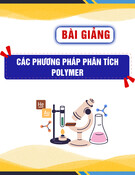


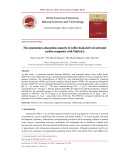
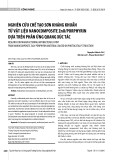
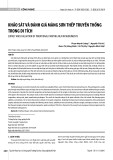
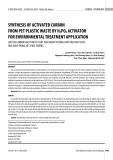
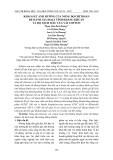

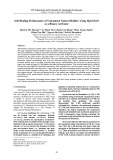












![Bài giảng Hình học họa hình: Bài mở đầu - Giới thiệu [Chuẩn SEO]](https://cdn.tailieu.vn/images/document/thumbnail/2025/20250823/kimphuong1001/135x160/99131755935505.jpg)


